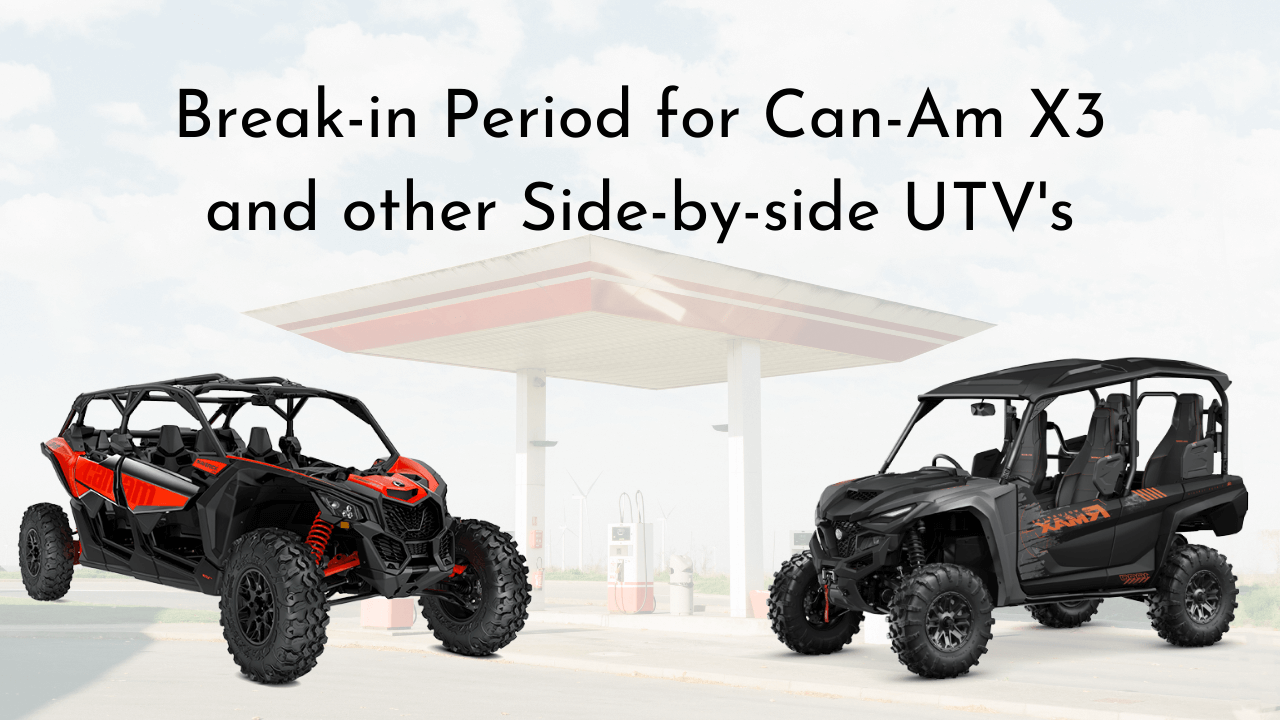When it comes to the break-in period for Can-Am X3, it usually means running your new engine, usually under a specific load for a particular time or mileage. It is the process of the moving parts in the engine that wear against each other to adjust and settle in order to work longer.
I highly recommend that you read your manual, as there is a safety checklist for you to complete before even running in your engine. If, for some reason, you can’t find your manual, select your model and year here.
WHAT IS THE CAN-AM X3 BREAK-IN PERIOD?
The Can-Am X3 and other side-by-side UTVs require a break-in period of ten operating hours or 200 miles. According to the Can-Am X3 manual, during this period, it is important to avoid full throttle, sustained accelerations, or prolonged cruising speeds. You should also avoid pressing the accelerator pedal more than ¾ of the stroke. However, brief accelerations and speed variations are beneficial for a good break-in. To sum it up, simply ride your Can-Am X3 on a trail without pushing it too hard, use common sense, and enjoy the experience.
WHY IS THERE A BREAK-IN PERIOD
The break-in period for Can-AM X3 and other side-by-side UTVs is important for the overall life and durability of your vehicle. However, as engine manufacturing technology has evolved, this break-in period has become shorter, typically around 5-10 hours. The goal of engine breaking-in is to set the piston rings into the engine’s cylinder wall. The cylinder wall is not perfectly smooth, and a break-in helps “seal” the piston rings against the wall. One possible reason for long break-in recommendations is that if the manufacturer can convince you to ride gently early on, they are less likely to have to repair anything under warranty.
WHAT IS THE BREAK-IN PERIOD IN SIDE-BY-SIDE OR UTV’S
So, you’ve just bought a shiny new Side-by-Side or UTV, and you’re itching to take it out for a spin. But before you rev that engine and hit the trails, there’s one important thing to keep in mind: the break-in period.
Think of it as a warm-up for your new engine. It’s an opportunity for all those little parts to get to know each other, adjust, shift and seal up properly so they can work together like a well-oiled machine. It’s kind of like a first date for your engine’s parts. You want to take it slow, get to know each other, and build trust before you really start to push it to the limits.
But don’t worry, this break-in period doesn’t mean you have to spend hours puttering around in your driveway. Just take it easy on the throttle, avoid high speeds and heavy loads, and before you know it, you’ll be ready to take your UTV out for a wild ride.
HOW TO PROPERLY BREAK IN YOUR NEW CAN-AM OR OTHER UTV
First things first, before you even think about hitting the gas pedal, you need to do a little pre-game warm-up. This includes inspecting your UTV, making sure everything is in working order, and going through a checklist that can usually be found in the manual (because who wants to read the manual, right?)
Each engine has specific requirements, so make sure you’re following the manufacturer’s guidelines. But don’t worry; it’s not rocket science – just don’t go full throttle and don’t push your UTV too hard.
START WITH LOW POWER.
Starting with low power is crucial during the engine break-in period. As per most instruction manuals, it is recommended to begin the break-in process by using low power and gradually increasing and decreasing power at intervals. This approach allows the engine to adjust and adapt to the increased power smoothly. By going easy on the throttle during the initial stages of a break-in, the engine is able to respond better when more power is added later on. This ensures that the engine is not subjected to too much stress or strain during the break-in period, which in turn prolongs the life of the engine and ensures optimal performance.
Varying your speed on the road by accelerating between speeds of 20 to 40 miles per hour, for example, is known as “pulsing.” This technique allows you to gradually increase your speed and maintain a steady pace while minimizing wear and tear on your vehicle.
After the initial break-in period, you can start using your vehicle on a higher power or rougher terrain without worrying about the RPMs too much. The RPMs of the Can-Am X3 typically do not exceed 3000 and most often stay between 1500-2000 RPM. This is because the engine is designed to operate efficiently at this range, resulting in minimal oil consumption and no need for limits on time or distance until the engine is bored out.
BREAK IN BY THE BOOK, OR BREAK IT ROUGH!
The guys from MC Garage tested the two break-in methods by building up two engines, breaking them in using drastically different methods, and then tearing them down and comparing the components. Their result was surprising. Engine 1, “By The Book Break-In,” and Engine 2, “Brutal Break-In,” had almost the same if not identical break- before and after components.
Check the video below.
How many miles to break in Can-Am?
Can-Am UTVs have varying mileage requirements for breaking them in, depending on the specific model. Generally, it is recommended to put around 200 to 300 miles on the vehicle before taking it off-road or using it for heavy-duty tasks. This is because Can-Am UTVs are designed for off-road use and require more frequent service than standard UTVs.
It is important to note that the break-in period for Can-Am X3 is not just a matter of convenience – it is crucial for ensuring the longevity of the engine. During the break-in period, the engine components are still adjusting to each other, and the oil is still breaking in. By following the recommended mileage for break-ins, you are helping to ensure that your engine runs smoothly and efficiently for years to come. Additionally, it is important to follow the manufacturer’s recommended maintenance schedule to ensure that your UTV stays in top condition.

